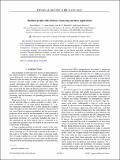Files in this item
Random graphs with arbitrary clustering and their applications
Item metadata
| dc.contributor.author | Mann, Peter Stephen | |
| dc.contributor.author | Smith, V Anne | |
| dc.contributor.author | Mitchell, John B. O. | |
| dc.contributor.author | Dobson, Simon Andrew | |
| dc.date.accessioned | 2021-02-04T16:30:14Z | |
| dc.date.available | 2021-02-04T16:30:14Z | |
| dc.date.issued | 2021-01-22 | |
| dc.identifier | 271506372 | |
| dc.identifier | bce5e5b0-36b3-4eb3-9c3d-8f85876a236e | |
| dc.identifier | 85099791332 | |
| dc.identifier | 000610780300004 | |
| dc.identifier.citation | Mann , P S , Smith , V A , Mitchell , J B O & Dobson , S A 2021 , ' Random graphs with arbitrary clustering and their applications ' , Physical Review. E, Statistical, nonlinear, and soft matter physics , vol. 103 , no. 1 , 012309 . https://doi.org/10.1103/PhysRevE.103.012309 | en |
| dc.identifier.issn | 1539-3755 | |
| dc.identifier.other | ORCID: /0000-0002-0379-6097/work/88267130 | |
| dc.identifier.other | ORCID: /0000-0002-0487-2469/work/88267307 | |
| dc.identifier.other | ORCID: /0000-0001-9633-2103/work/88268306 | |
| dc.identifier.uri | https://hdl.handle.net/10023/21376 | |
| dc.description.abstract | The structure of many real networks is not locally treelike and, hence, network analysis fails to characterize their bond percolation properties. In a recent paper [P. Mann, V. A. Smith, J. B. O. Mitchell, and S. Dobson, arXiv:2006.06744], we developed analytical solutions to the percolation properties of random networks with homogeneous clustering (clusters whose nodes are degree equivalent). In this paper, we extend this model to investigate networks that contain clusters whose nodes are not degree equivalent, including multilayer networks. Through numerical examples, we show how this method can be used to investigate the properties of random complex networks with arbitrary clustering, extending the applicability of the configuration model and generating function formulation. | |
| dc.format.extent | 10 | |
| dc.format.extent | 1116940 | |
| dc.language.iso | eng | |
| dc.relation.ispartof | Physical Review. E, Statistical, nonlinear, and soft matter physics | en |
| dc.subject | Complex networks | en |
| dc.subject | Random graphs | en |
| dc.subject | Clustered networks | en |
| dc.subject | QA Mathematics | en |
| dc.subject | QA75 Electronic computers. Computer science | en |
| dc.subject | QC Physics | en |
| dc.subject | T-NDAS | en |
| dc.subject.lcc | QA | en |
| dc.subject.lcc | QA75 | en |
| dc.subject.lcc | QC | en |
| dc.title | Random graphs with arbitrary clustering and their applications | en |
| dc.type | Journal article | en |
| dc.contributor.institution | University of St Andrews. School of Chemistry | en |
| dc.contributor.institution | University of St Andrews. Office of the Principal | en |
| dc.contributor.institution | University of St Andrews. St Andrews Centre for Exoplanet Science | en |
| dc.contributor.institution | University of St Andrews. Centre for Biological Diversity | en |
| dc.contributor.institution | University of St Andrews. Scottish Oceans Institute | en |
| dc.contributor.institution | University of St Andrews. Institute of Behavioural and Neural Sciences | en |
| dc.contributor.institution | University of St Andrews. School of Biology | en |
| dc.contributor.institution | University of St Andrews. St Andrews Bioinformatics Unit | en |
| dc.contributor.institution | University of St Andrews. EaSTCHEM | en |
| dc.contributor.institution | University of St Andrews. Biomedical Sciences Research Complex | en |
| dc.contributor.institution | University of St Andrews. School of Computer Science | en |
| dc.contributor.institution | University of St Andrews. Sir James Mackenzie Institute for Early Diagnosis | en |
| dc.identifier.doi | https://doi.org/10.1103/PhysRevE.103.012309 | |
| dc.description.status | Peer reviewed | en |
| dc.identifier.url | http://arxiv.org/abs/2006.08427 | en |
This item appears in the following Collection(s)
Items in the St Andrews Research Repository are protected by copyright, with all rights reserved, unless otherwise indicated.

